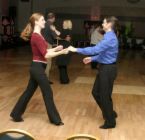|
Below, you'll find extensive information on leading
belly dancing articles and products to help you on your way
to success.
Learn To Dance The Salsa
By Gray Rollins
The word ďsalsaĒ in Spanish means sauce. Salsa is also known as slot because couples donít move around a large area of the dance floor; instead they stay in a more fixed or smaller area of the floor. So are you ready to learn Salsa dancing?
The salsa has an eight beat pattern that is made up of two bars of four beats. The Salsa music is usually complicated and fast with around 180 beats per minute. The salsa pattern is generally one of three steps and then a skipped step or a tap on the fourth beat.
The basic step is as follows: On counts 1, 2, and 3 the leader steps forward, then you replace the weight to your previous support foot keeping it in place, and then step backward. On counts 5, 6, and 7 you step backwards, then you replace the weight to your previous support foot keeping it in place, and then step forward again.
The follower does exactly the same steps but in the reverse order. The basic step is the basis for many of the other salsa patterns.
Some of the breaks to the basic step are:
1. Side Break Ė You start from either foot and step sideways; then you replace the weight to your previous support foot, keeping it in place.
2. Back Break - You start from either foot and step backwards; then you replace the weight to your previous support foot, keeping it in place.
3. Forward Break - You start from either foot and step forward; then you replace the weight to your previous support foot, keeping it in place.
There are many different salsa styles that involve different timing of the steps or different patterns as you move across the dance floor. Combine style with attitude and personal add ins and you get quite the salsa show!
The Cuban style can be danced as a contratiempo or on-one. With the Cuban Salsa, on counts 1, 2, and 3 a backward basic occurs
while on counts 5, 6, and 7 a forward basic happens. The follower mirrors the leaderís movements. It is common practice with the Cuban to have the leader and follower circle each other regularly.
The Dile que no or cross body lead is also essential to the Cuban. This is the most complex of moves and is not designed for beginners. However, once you master it, it can be used in the Rueda, Cuban Casino, and Wheel Dance.
In Latin American countries the Columbian style is the most common. Here the leader and follower do their moves standing in one place. Most of the moves are based off the Cuban style with the main difference being lack of space involved. Itís a very sexy version to watch!
The LA style is a derivative of the Cuban style with the addition of the cross body lead. The leader steps forward on 1, on 2 and 3 itís a step to the right while turning 90 degrees to face to the left. The follower then steps forward on 5 and 6, then on 7 and 8 turns while the leader is making the 90 degree turn. By the 8 count the leader and follower are in opposite positions. The Los Angeles is the flashiest form of Salsa dancing.
Thatís just a few of the most common styles. Of course there are plenty others, and then thereís always the creative element that comes into play.
Learning the Salsa from an article can be a bit overwhelming, but if you really want to learn it check into either local dance classes or online dance lessons. Youíll be Salsa like a pro in no time! Gray Rollins is a featured writer for Salsa Legends. To learn more about salsa lessons and salsa DVDs, visit us.
|
|
We strive to provide only quality articles, so if there
is a specific topic related to dancing that you
would like us to cover, please contact us at any time.
And again, thank you to those contributing daily to our
belly dancing website.
|

